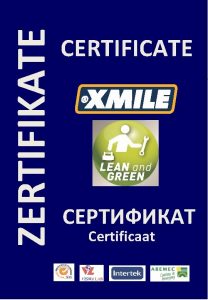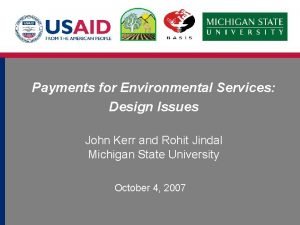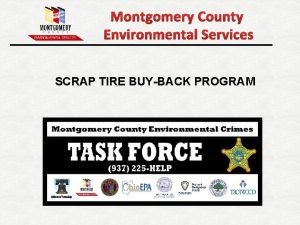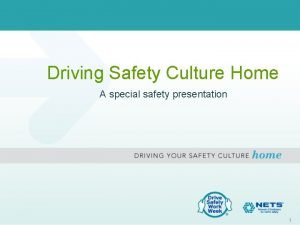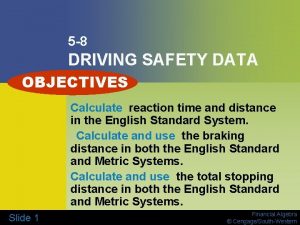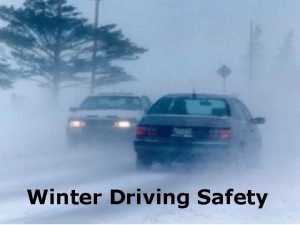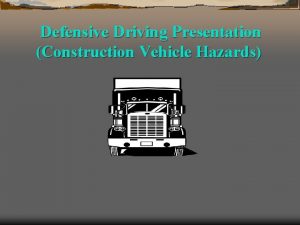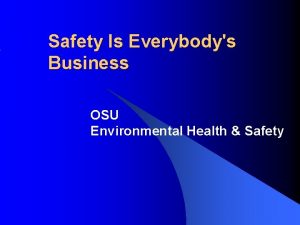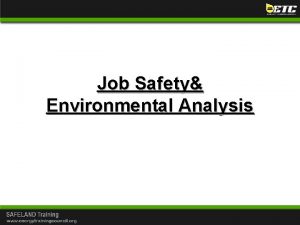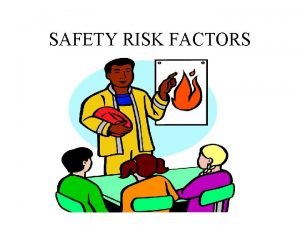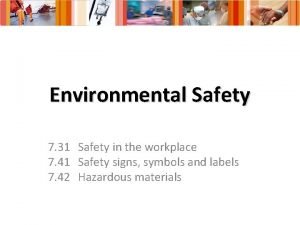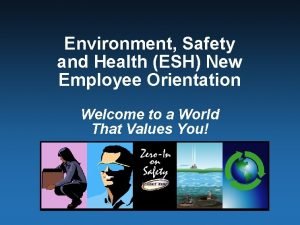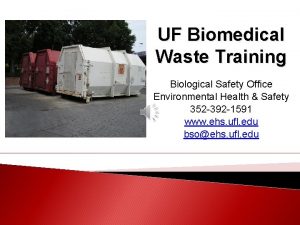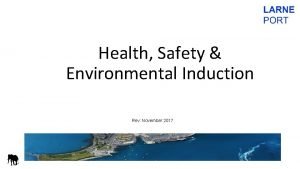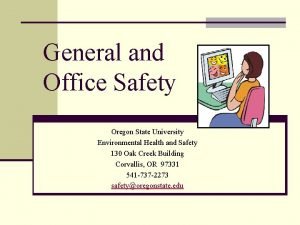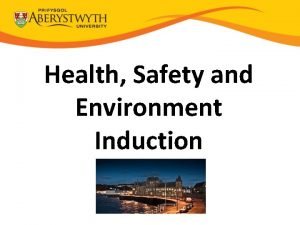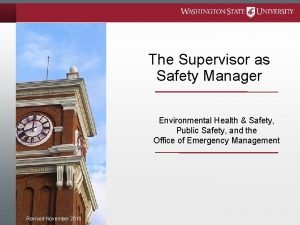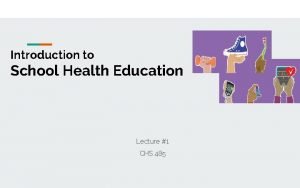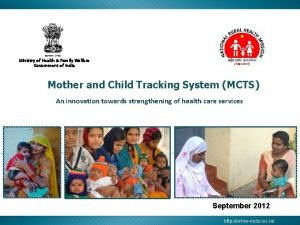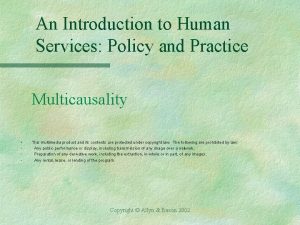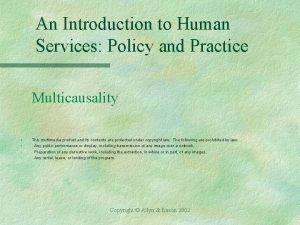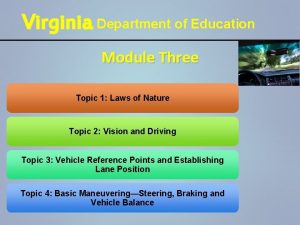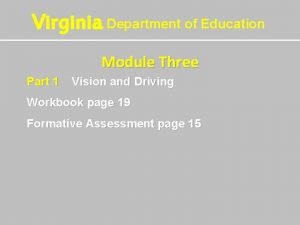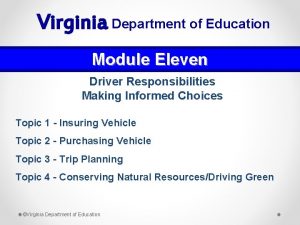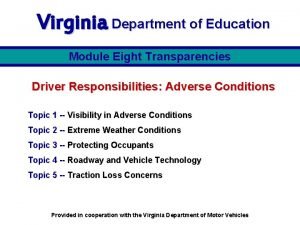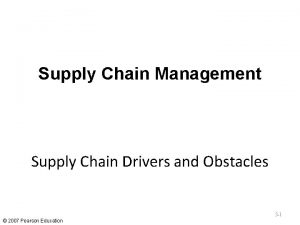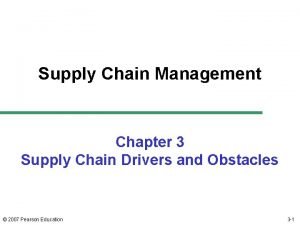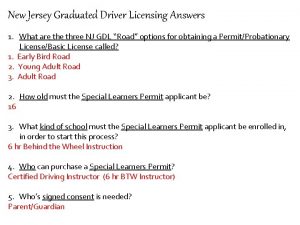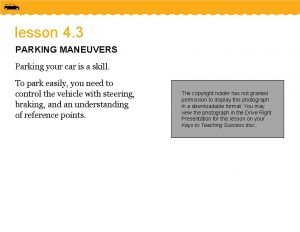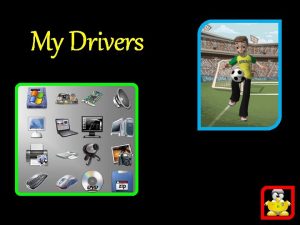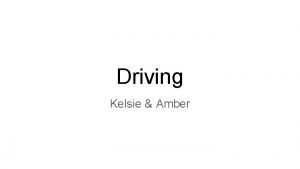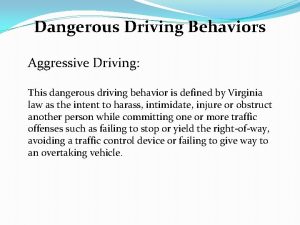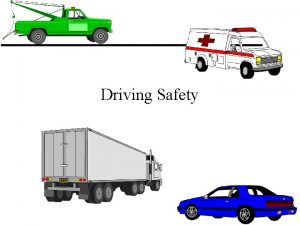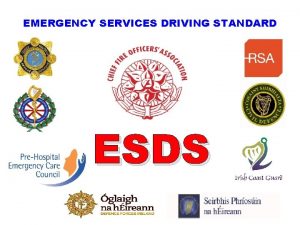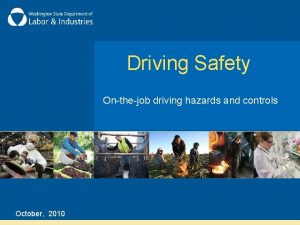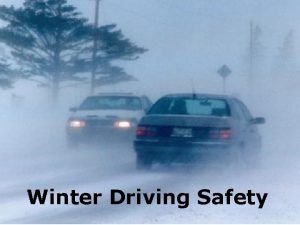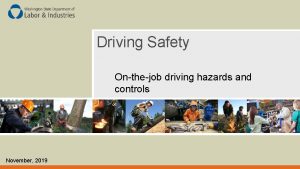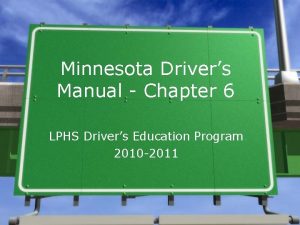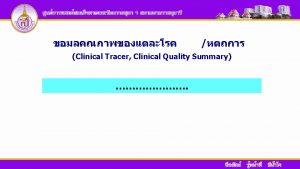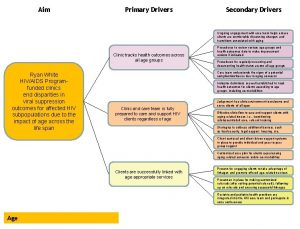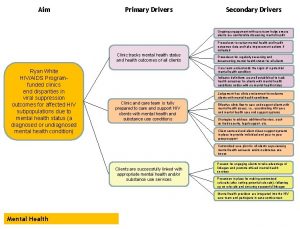Drivers Safety Environmental Safety Services Driving Safety Introduction















































- Slides: 47

Drivers Safety Environmental & Safety Services

Driving Safety Ü Introduction Statistics Ü Unsafe Actions / Unsafe Conditions Ü Vehicle Safety Features Ü Driving Tips Road Rage Backing Highway/City/Rural Driving at Dusk Rush hour Winter Weather

Driving Safety (continued) Ü Use of Seat Belts Ü Van Facts Ü Accidents ÜQ & A

DRIVE TO STAY ALIVE Ü THE #1 LEADING CAUSE OF “AT WORK” DEATHS IS VEHICLE ACCIDENTS. Ü MOST OF US BEGAN DRIVING WHEN WE WERE TEENAGERS AND AFTER SO MANY YEARS, TEND TO REINFORCE POOR ROAD HABITS.

Ü 25% of all driving accidents are the result of excessive speed. Ü 70% of driving accidents occur within 25 miles from home. Ü 1 out of 4 employees who drive experience an accident while at work. Ü Most people know someone who has died in a car accident.

Ü 2001 data for the U. S. 37, 409 deaths 2, 070, 000 injuries 115 deaths per day Friday (especially evening/night hours) has more fatal accidents than any other day Midnight to 3 a. m. on Saturdays and Sundays proved to be the deadliest 3 -hour periods throughout 1999, with 1, 215 and 1, 182 fatal crashes, respectively. Ü Michigan – 1, 382 Fatalities – Isabella County (73)

Ü Motor vehicle crashes cause a death every 12 minutes, a disabling injury every 14 seconds. Ü When do most accidents occur (type of weather)? Clear sunny days, good visibility Ü Seat belts are mandatory for all occupants

More than 600, 000 people ages 15 to 20 were injured in traffic accidents last year.

Ü 60 percent of crashes with deaths or injuries happen on roads with posted speed limits of 40 miles per hour or less.

Ü Motor vehicle crashes cost society more than 150. 5 billion per year. These were based on costs that arose from crashes that killed 40, 716 people and injured 5. 2 million others. Ü By comparison personal and household crimes cost their victims $19 billion.

Driving injuries - on or off the job Ü The most hazardous environment For most of us, whether on or off the job, it is on the road. We face it daily. ÜA recent report from the road: A manager was beginning a business trip Was driving from his house to the airport on the freeway Was shaving and looking into the rearview mirror Saw (in peripheral vision) something cut in front of him Reacted by steering to the right, driving off the freeway and hitting a tree

Ü Shaving Ü Putting on make-up Ü Reading a map or book Ü Using the cell phone Certain state(s) law prohibits use Ü Not using a seatbelt Ü Driving under the influence Ü Driving at an unsafe speed Ü Failing to stop or yield Ü Unsafe passing of another vehicle Ü Tailgating Ü Not using blinkers Ü Eating Driver eats first

Ü Poor visibility Night time driving (Fatality rates/mile are 4 times higher at night. ) Dust storms Rain storms Snow Fog Windshield wipers not effective Ü Poor road conditions Slippery surfaces from weather Road not properly maintained Ü Improper vehicle maintenance Inadequate brakes Worn tread on tires Hoses, belts Inadequate acceleration Headlight(s) out

Driving under the influence (DUI) Ü Alcohol was involved in 41% of all traffic fatalities in ‘ 94 Ü Sobering facts: About 2 in every 5 Americans will be involved in an alcohol-related traffic accident at some time in their lives Remember the one-one rule: one drink per hour (Your body takes about an hour to rid itself of each 1/2 ounce of alcohol)

Ü Daytime running lights (Headlights that are on whenever vehicle is running) Ü Lap/shoulder safety belts Reduce risk of moderate-tofatal injuries by approximately 50%. Ü Air bags for driver & passenger Combined with lap/shoulder belts, they reduce risk of fatality by another 10%. Ü Side impact airbags Anti-lock brakes Ü Safety cages built into the vehicle framework Ü

Did you know? Ü When driving on a road that is new to you: Your eyes tend to scan the road from left to right which is an excellent driving habit. We tend not to scan when in familiar territory. Ü How closely can you safely follow another car? We tend to follow based on how much of the road we can see – A long hood causes us to follow at a greater distance (since you have to look over the hood to see the street). – Drivers with shorter hoods tend to follow more closely Use the 2 or 4 second rule – Good driving conditions, keep a 2 second distance behind – Poor driving conditions, keep a 4 second distance behind

Ü Slow Down Ü Avoid sharp turns. Ü Avoid excessive speed and abrupt maneuvers. Ü Don’t drive tired (6 hours max. ). Ü Drive conservatively Ü Rest stops often (every 2 hrs. recommended) Ü Wear seat belts Ü Drive during the day, if possible. Ü Require someone to be awake in the front seat with the driver on long trips

Ü Road rage is driving under the influence of too much anger. Ü Provoked by: Feeling endangered by someone else’s driving (another driver cuts you off or tailgates you). Resentment at being forced to slow down Righteous indignation at someone who breaks traffic rules Anger at someone taking out their road rage on you Ü Therapy for road rage: Take a deep breath and just let it go! SRTCC

Defensive Driving Theories Ü Drive with courtesy Ü Be calm when driving Ü Concentrate when driving Ü Drive cautiously

Dealing With Aggressive Drivers Ü Avoid eye contact. Ü Don’t cut in front of other drivers. Ü Allow fellow drivers to merge Ü Don’t aggravate fellow drivers with hand gestures. Ü Don’t tailgate. Ü Use your horn sparingly.

Backing The Vehicle Ü Use a spotter Ü Back to the left (driver’s side) Ü Avoid backing up if you miss a ramp/exit. Ü Use outside mirrors.

Highway Driving Ü Lane changes and signals. Ü Merges Ü Blind Spots Ü Slow moving vehicles

City Driving Ü Stop signs Ü Stop lights Ü Yield Signs Ü Signals Ü Blind spots Ü Pedestrians Ü Bicyclist

Rural Driving Ü Bicyclist Ü Walkers Ü Deer/Moose Ü Soft shoulders Ü Culverts Ü Curves, hills and narrow roads

Driving at Dusk Be especially alert at dusk. The sky still is quite bright, but objects on the road can merge with shadows and fade into darkness.

Emergency Situations Ü Encountering emergency vehicles Ü Headlights go out Ü Tire blow out Ü Engine failure Ü Brake Failure

Ü Lousy Weather, Rush Hour Traffic, and construction zones are all challenges that require good driving skills. To help yourself stay SAFE, always wear your safety belt, and follow these next few tips!

Ü Drive with courtesy Ü Be calm when driving Ü Concentrate when driving Ü Drive cautiously Ü Obey all traffic laws Ü Watch for road signs, workers, and detours. Ü Expect to encounter slow trucks and other construction traffic.

From 6: 00 a. m. to 9: 00 a. m. drivers may be sleepy or trying to make up for lost time. Stay aware and try to get an early start. Ü From 4: 00 p. m. to 7: 00 p. m. drivers may be thinking about getting home and work stresses. Don’t let the cars around you control your driving. RELAX and adjust to a SAFE speed. Ü

Ü Ü Ü “Peephole” driving. What’s the hurry? Leave early and take it slow. Reduce your speed, especially on bridges, which may freeze before the road does. Avoid un-necessary stops. You may loose momentum and/or control. Increase the distance between you and the car in front of you by at least 4 seconds to give yourself adequate time to stop.

Speed ÜThe chance of death or serious injury doubles for every 10 miles per hour over 50 miles per hour that a vehicle travels. ÜOne mile per hour is approximately 1. 5 feet per second. Therefore, a vehicle traveling 60 miles per hour is covering 90 feet per second.

Drive with your headlights on !! Although not the law, driving with your low-beam headlights on during daylight hours makes you much more visible to other drivers.

Safety Belts and restraints Ü In 1995, if every person in the front passenger seat had buckled up, an additional 9835 deaths could have been prevented.

Seat belt myths Ü How many of these myths have you heard ? I don’t need a safety belt when I’m traveling at low speeds or going on a short trip. More than 80 percent of all motor vehicle crashes occur at speeds less than 40 MPH and within 25 miles from home.

Seat belt myths Ü How many of these myths have you heard ? I’m uncomfortable and too confined when I wear a safety belt. Safety belts are designed to allow you to reach necessary driving controls. The newer shoulder belt retractors give you even more freedom.

Seat belt myths Ü How many of these myths have you heard ? I might be saved if I’m thrown clear of a car in a crash. The fact is that your chances of being killed are FOUR times greater if you’re thrown from a car.

BOTTOM LINE ALWAYS WEAR YOUR SEAT BELT “IT’S THE LAW”

Ü Caravans Be mindful of your distance between vehicles Both vehicles should know where they are going 2 -way radio for all vehicles and cellular phone for leader on multi-vehicle trips. Obey all laws, signs and speed limits.

ÜA speed that may be acceptable in a passenger car could be dangerous in a van. Ü You should fill the front seats first. The center of gravity shifts to the rear and upward increasing the likelihood of rollover as capacity increases. Ü Soft shoulders and culverts pose a hazard in rural areas. Ü The shift in the center of gravity will also increase the potential for loss of control in panic maneuvers.

Ü Vans have an increased rollover risk under certain conditions Ü The risk of rollover increases dramatically as the number of occupants increases from fewer than five occupants to over ten passengers. Ü Vans (with 10 or more occupants) had a rollover rate in single vehicle crashes that is nearly 3 x the rate of those that were lightly loaded.

Ü Loading vans causes the center of gravity to shift rearward and upward increasing the likelihood of rollover. Shift in the center of gravity will also increase the potential for loss of control in panic maneuvers. Ü It is important that the van be operated by experienced drivers. They should understand be familiar with the handling principles of their vans, especially when fully loaded.

Ü Any load placed on the roof will be above the center of gravity of the vehicle and will increase the likelihood of rolling over.

Ü Relax Ü Never leave the scene of an accident. Ü Take a photo or two of the accident with site camera. Ü Report the accident to the police. Ü Never admit fault. Ü Gather all the facts (date, time, witnesses, phone numbers, etc. ) Ü Immediately report all accidents to your advisor Shawna Ross.

Ü Final Thought… Responsibility to others in your vehicle – Their loved ones Responsibility to yourself – Your loves ones Responsibility to the General Public

Drive safely to ensure your family, friends and yourself that you’ll return home safely. 'Tis the Season But Please Remember: Friends Don’t let friends drink and drive!

Questions?

The End
 How emotions affect driving
How emotions affect driving Mh 605
Mh 605 Kingspan environmental services
Kingspan environmental services Intertek nederland
Intertek nederland Kerr environmental services
Kerr environmental services Montgomery county tire buyback
Montgomery county tire buyback Pine environmental locations
Pine environmental locations Unyse
Unyse Metropolitan council environmental services
Metropolitan council environmental services Winter driving safety presentation
Winter driving safety presentation 5-8 driving safety data
5-8 driving safety data Winter driving safety topics
Winter driving safety topics Defensive driving training course ppt
Defensive driving training course ppt Nultify
Nultify Unit 1 introduction to environmental science
Unit 1 introduction to environmental science Environmental awareness introduction
Environmental awareness introduction Osu environmental health and safety
Osu environmental health and safety Job safety environmental analysis
Job safety environmental analysis Portal of entry
Portal of entry Environmental safety signs
Environmental safety signs Esh environmental safety health
Esh environmental safety health Ehs uf
Ehs uf No work prior to safety/environmental induction sign
No work prior to safety/environmental induction sign Ehs oregon state
Ehs oregon state Aberlearn
Aberlearn Wsu environmental health and safety
Wsu environmental health and safety Penn state environmental health and safety
Penn state environmental health and safety Intserv vs diffserv
Intserv vs diffserv Wake county human services community services center
Wake county human services community services center Introduction of school health services
Introduction of school health services Mcts registration number maharashtra
Mcts registration number maharashtra An introduction to human services policy and practice
An introduction to human services policy and practice Multicausality in human services
Multicausality in human services Module 3 topic 1
Module 3 topic 1 Roll drivers ed
Roll drivers ed Module 10 topic 2 drivers ed
Module 10 topic 2 drivers ed Module 5 intersections and roundabouts
Module 5 intersections and roundabouts Module 11 drivers ed virginia
Module 11 drivers ed virginia Module 8 topic 1
Module 8 topic 1 Overgeneralization psychology
Overgeneralization psychology Gdl upgrade nj
Gdl upgrade nj Strokes ta
Strokes ta Framework for structuring drivers
Framework for structuring drivers Drivers of supply chain management
Drivers of supply chain management What does the yield sign mean drivers ed
What does the yield sign mean drivers ed Graduated drivers license nj
Graduated drivers license nj Mobile computing and mobile commerce
Mobile computing and mobile commerce 3 parking maneuvers
3 parking maneuvers



